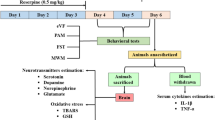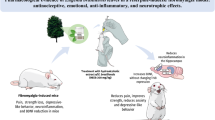Abstract
Fibromyalgia is a refractory syndrome characterized by chronic wayward pain and complex co-morbid psychological trepidation. The current treatments have a limited role and proper clinical benefits are far from satisfactory. Naturally occurring coumarins such as osthole are known to have analgesic and anti-inflammatory activities. Therefore, the current investigation was designed to explore the potential of natural coumarin esculetin (2.5, 5, and 10 mg/kg) in mitigating reserpine-induced fibromyalgia in Swiss albino mice. Esculetin is a 6,7 dihydroxy-coumarin obtained from various plant sources such as Aesculus hippocastanum L, Ceratostigma willmottianum, Citrus limonia, etc. Reserpine (0.5 mg/kg/day s.c.) treatment for first 3 days, significantly altered the behavior of mice as evidenced by reduced paw withdrawal threshold in pressure application measurement (PAM) test and electronic von-Frey (eVF) test, increased immobility time in forced swim test (FST), increased latency to reach the platform in Morris water maze (MWM) test and reduced number of square crossed in the open field test (OFT). These behavioral deficits with reserpine treatment were integrated with a reduced level of serotonin (5-HT), reduced glutathione (GSH), along with an increase in monoamine oxidase-A (MAO-A) activity, pro-inflammatory cytokines (IL-1β, TNF-α), thiobarbituric acid reactive substances (TBARS) and glutamate level. Esculetin (10 mg/kg/day i.p) treatment for 5 days, significantly abrogated reserpine induced behavioral and biochemical alterations. Whereas, no significant improvement was observed with lower doses of esculetin i.e. 2.5 and 5 mg/kg.






Similar content being viewed by others
References
Sluka KA, Clauw DJ (2016) Neurobiology of fibromyalgia and chronic widespread pain. Neuroscience 338:114–129
Kaur A, Singh L, Singh N, Bhatti MS, Bhatti R (2019) Ameliorative effect of imperatorin in chemically induced fibromyalgia: role of NMDA/NFkB mediated downstream signaling. Biochem Pharmacol 166:56–69
Heymann RE, Paiva ES, Martinez JE, Helfenstein M, Rezende MC, Provenza JR, Ranzolin A, Assis MR, Feldman DP, Ribeiro LS, Souza EJR (2017) New guidelines for the diagnosis of fibromyalgia. Rev Bras Reumatol Engl Ed 57:467–476
Singh L, Kaur A, Bhatti MS, Bhatti R (2019) Possible molecular mediators involved and mechanistic insight into fibromyalgia and associated co-morbidities. Neurochem Res. 44:1–16
Gracely RH, Petzke F, Wolf JM, Clauw DJ (2002) Functional magnetic resonance imaging evidence of augmented pain processing in fbromyalgia. Arthritis Rheum-US 46:1333–1343
Rizzi C, Tiberi A, Giustizieri M, Marrone MC, Gobbo F, Carucci NM, Meli G, Arisi I, D’Onofrio M, Marinelli S, Capsoni S (2018) NGF steers microglia toward a neuroprotective phenotype. Glia 66:1395–1416
Block ML, Zecca L, Hong JS (2007) Microglia-mediated neurotoxicity: uncovering the molecular mechanisms. Nat Rev Neurosci 8:57–69
Fatima G, Mahdi F (2017) Deciphering the role of oxidative and antioxidative parameters and toxic metal ion content in women with Fibromyalgia Syndrome. Free Radic Biol Med 112:23–24
Ohgidani M, Kato TA, Hosoi M, Tsuda M, Hayakawa K, Hayaki C, Iwaki R, Sagata N, Hashimoto R, Inoue K, Sudo N (2017) Fibromyalgia and microglial TNF-α: Translational research using human blood induced microglia-like cells. Sci Rep 7:11882
Ruediger T, Bolz J (2007) Neurotransmitters and the development of neuronal circuits. Axon Growth Guidance 621:104–115
Zieglgänsberger W (2019) Substance P and pain chronicity. Cell Tissue Res 375:227–241
Jordan ML, Rominski B, Jaquins-Gerstl A, Geller D, Hoffman RA (1995) Regulation of inducible nitric oxide production by intracellular calcium. Surgery 118:138–145
Murugan M, Ling EA, Kaur C (2013) Glutamate receptors in microglia. CNS Neurol Disord Drug Targets 12:773–784
Welsch P, Üçeyler N, Klose P, Walitt B, Häuser W (2018) Serotonin and noradrenaline reuptake inhibitors (SNRIs) for fibromyalgia. Cochrane Database Syst Rev 2018:CD010292
Naoi M, Maruyama W, Shamoto-Nagai M (2018) Type A monoamine oxidase and serotonin are coordinately involved in depressive disorders: from neurotransmitter imbalance to impaired neurogenesis. J Neural Transm 125:53–66
Nagakura Y, Oe T, Aoki T, Matsuoka N (2009) Biogenic amine depletion causes chronic muscular pain and tactile allodynia accompanied by depression: a putative animal model of fibromyalgia. Painesa 146:26–33
DeSantana JM, da Cruz KM, Sluka KA (2013) Animal models of fibromyalgia. Arthritis Res Ther 15:222
Eiden LE, Weihe E (2011) VMAT2: a dynamic regulator of brain monoaminergic neuronal function interacting with drugs of abuse. Ann N Y Acad Sci 1216:86
Yaffe D, Forrest LR, Schuldiner S (2018) The ins and outs of vesicular monoamine transporters. J Gen Physiol 150:671–682
Dedhia JD, Bone ME (2009) Pain and fibromyalgia Continuing education in anaesthesia. Crit Care Med 9:162–166
Kia S, Choy E (2017) Update on treatment guideline in fibromyalgia syndrome with focus on pharmacology. Biomedicines 5:20
Thomford N, Senthebane D, Rowe A, Munro D, Seele P, Maroyi A, Dzobo K (2018) Natural products for drug discovery in the 21st century: innovations for novel drug discovery. Int J Mol Sci 19:1578
Jeon YJ, Jang JY, Shim JH, Myung PK, Chae JI (2015) Esculetin a coumarin derivative exhibits anti-proliferative and pro-apoptotic activity in G361 human malignant melanoma. Eur J Cancer Prev 20:106
Liang C, Ju W, Pei S, Tang Y, Xiao Y (2017) Pharmacological activities and synthesis of esculetin and its derivatives: a mini-review. Molecules 22:387
Sulakhiya K, Keshavlal GP, Bezbaruah BB, Dwivedi S, Gurjar SS, Munde N, Jangra A, Lahkar M, Gogoi R (2016) Lipopolysaccharide induced anxiety-and depressive-like behaviour in mice are prevented by chronic pre-treatment of esculetin. J Neuroinflamm 611:106–111
Zhu L, Nang C, Luo F, Pan H, Zhang K, Liu J, Zhou R, Gao J, Chang X, He H, Qiu Y (2016) Esculetin attenuates lipopolysaccharide (LPS)-induced neuroinflammatory processes and depressive-like behavior in mice. Physiol Behav 163:184–192
Wang Z, Wang Q, Wang C, Xu X, Yu H (2017) Tetramethylpyrazine attenuates periorbital allodynia and neuroinflammation in a model of traumatic brain injury. J Inflamm 14:13
Deuis JR, Dvorakova LS, Vetter I (2017) Methods used to evaluate pain behaviors in rodents. Front Mol Neurosci 10:284
Guo YY, Liu SB, Cui GB, Ma L, Fen B, Xing JH, Yang Q, Li XQ, Wu YM, Xiong LZ, Zhang W (2012) Acute stress induces down-regulation of large conductance Ca2 + activated potassium channels in the lateral amygdala. J Physiol 590:875–886
Porsolt RD, Le Pichon M, Jalfre M (1977) Depression: a new animal model sensitive to antidepressant treatments. Nature 266:730–732
Morris RG (1981) Spatial localization does not depend on the presence of local cues. Learn Motiv 12:239–260
Kaur S, Kaur A, Singh G, Bhatti R (2018) Mercurius solubilis attenuates scopolamine-induced memory deficits and enhances the motor coordination in mice. Int J Neurosci 128:219–230
Arora V, Chopra K (2013) Possible involvement of oxido-nitrosative stress induced neuro-inflammatory cascade and monoaminergic pathway: underpinning the correlation between nociceptive and depressive behaviour in a rodent model. J Affect Disord 151:1041–1052
Kasthuri S, Kavimani S, Devi R, Sundhararajan R, Deepa N (2015) Anticonvulsant activity of mahakalayanakaghrita in maximalelectro-shock and pentylenetetrazoleinduced seizures in rats. Int Res J Pharm 6:715–719
Kim SH, Kim SH, Kim SK, Nam EJ, Han SW, Lee SJ (2012) Spatial versus verbal memory impairments in patients with fibromyalgia. Rheumatol Int 32:1135–1142
Canovas R, León I, Roldán MD, Astur R, Cimadevilla JM (2009) Virtual reality tasks disclose spatial memory alterations in fibromyalgia. Rheumatology 48:1273–1278
Julien N, Goffaux P, Arsenault P, Marchand S (2005) Widespread pain in fibromyalgia is related to a deficit of endogenous pain inhibition. Pain 114:295–302
Henriksson KG, Mense S (1994) Pain and nociception in fibromyalgia: clinical and neurobiological considerations on aetiology and pathogenesis. Pain Rev 1:245–260
Andreae LC, Burrone J (2014) The role of neuronal activity and transmitter release on synapse formation. Curr Opin Neurobiol 27:47–52
Kuypers KP, Ramaekers JG (2005) Transient memory impairment after acute dose of 75 mg 3.4-Methylene-dioxymethamphetamine. J Psychopharmacol 19:633–639
Glikmann-Johnston Y, Saling MM, Reutens DC, Stout JC (2015) Hippocampal 5-HT1A receptor and spatial learning and memory. Front Pharmacol 6:289
Carr GV, Lucki I (2010) The role of serotonin in depression. In Handbook of Behavioral Neuroscience 21;493–505.
Vianello R, Repič M, Mavri J (2012) How are biogenic amines metabolized by monoamine oxidases? Eur J Org Chem 2012:7057–7065
Pirildar S, Sezgin U, Elbi H, Uyar M, Zileli B (2003) A preliminary open-label study of moclobemide treatment of pain disorder. Psychopharm Bull 37:127–134
Schreiber S, Getslev V, Weizman A, Pick CG (1998) The antinociceptive effect of moclobemide in mice is mediated by noradrenergic pathways. Neurosci Lett 253:183–186
Gursoy S, Erdal E, Sezgin M, Barlas IO, Aydeniz A, Alaşehirli B, Sahin G (2008) Which genotype of the MAO gene that the patients have are likely to be most susceptible to the symptoms of fibromyalgia? Rheumatol Int 28:307–311
Tort S, Urrútia G, Nishishinya MB, Walitt B (2012) Monoamine oxidase inhibitors (MAOIs) for fibromyalgia syndrome. Cochrane Database Syst Rev. 4:CD009807
Youdim MBH, Sandler M (1968) Activation of monoamine oxidase and inhibition of aldehyde dehydrogenase by reserpine. Eur J Pharmacol 4:105–108
Subakanmani S, Murugan S, Devi PU (2016) Evaluation of antidepressant like effects of ethanolic hypericum hookerianum and its glycosidic flavonoid enriched extract in reserpine induced swiss Albino Mice. Asian J Biochem 11:1–3
Golembiowska K, Dziubina A (2012) The effect of adenosine A 2A receptor antagonists on hydroxyl radical dopamine and glutamate in the striatum of rats with altered function of VMAT2. Neurotox Res 22:150–157
Bagis S, Tamer L, Sahin G, Bilgin R, Guler H, Ercan B, Erdogan C (2005) Free radicals and antioxidants in primary fibromyalgia: an oxidative stress disorder? Rheumatol Int 25:188–190
Maes M, Libbrecht I, Van Hunsel F, Lin AH, De Clerck L, Stevens W, Kenis G, de Jongh R, Bosmans E, Neels H (1999) The immune-inflammatory pathophysiology of fibromyalgia: increased serum soluble gp130, the common signal transducer protein of various neurotrophic cytokines. Psychoneuroendocrinology 24:371–383
Carballo-Villalobos AI, González-Trujano ME, Alvarado-Vázquez N, López-Muñoz FJ (2017) Pro-inflammatory cytokines involvement in the hesperidin antihyperalgesic effects at peripheral and central levels in a neuropathic pain model. Inflammopharmacology 25:265–269
Yang P, Gao Z, Zhang H, Fang Z, Wu C, Xu H, Huang QJ (2015) Changes in proinflammatory cytokines and white matter in chronically stressed rats. Neuropsychiatr Dis Treat 11:597–607
Zhang JM, An J (2007) Cytokines, inflammation and pain. Int Anesthesiol Clin 45:27
Kowluru RA, Odenbach S (2004) Role of interleukin-1β in the development of retinopathy in rats: effect of antioxidants. Invest Ophthalmol Vis Sci 45:4161–4166
Grzybowski AE (2000) Interleukin 1beta decreases the GSH content and catalase activity in the human peritoneal mesothelial cells in vitro. Arch Immunol Ther Exp 48:205
Mazereeuw G, Herrmann N, Andreazza AC, Khan MM, Lanctôt KL (2015) A meta-analysis of lipid peroxidation markers in major depression. Neuropsychiatr Dis Treat 11:2479
Maes M, Fisar Z, Medina M, Scapagnini G, Nowak G, Berk M (2012) New drug targets in depression: inflammatory, cell-mediated immune, oxidative and nitrosative stress, mitochondrial, antioxidant, and neuroprogressive pathways. And new drug candidates-Nrf2 activators and GSK-3 inhibitors. Inflammopharmacology 20:127–150
Acknowledgments
The authors are grateful to the Department of Science and Technology, Government of India, for funding received under EMR (EMR/2016/005878) and DST-PURSE. The authors gratefully acknowledge the financial support received from the University Grants Commission under RUSA scheme.
Funding
Department of Science and Technology, Government of India (EMR/2016/005878), DST-PURSE and University Grants Commission, RUSA scheme.
Author information
Authors and Affiliations
Corresponding author
Ethics declarations
Conflicts of Interest
The authors declare no conflicts of interest.
Ethics Approval
The entire study involving the use of mice was approved by the Institutional. Animal Ethics Committee (Approval No. 226/CPCSEA/2018/23) and the experiments were conducted according to ethical guidelines of the Ministry of Environment and Forests, Government of India.
Additional information
Publisher's Note
Springer Nature remains neutral with regard to jurisdictional claims in published maps and institutional affiliations.
Rights and permissions
About this article
Cite this article
Singh, L., Kaur, A., Garg, S. et al. Protective Effect of Esculetin, Natural Coumarin in Mice Model of Fibromyalgia: Targeting Pro-Inflammatory Cytokines and MAO-A. Neurochem Res 45, 2364–2374 (2020). https://doi.org/10.1007/s11064-020-03095-y
Received:
Revised:
Accepted:
Published:
Issue Date:
DOI: https://doi.org/10.1007/s11064-020-03095-y




